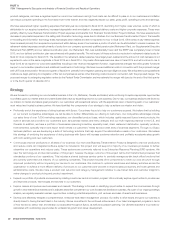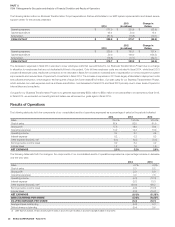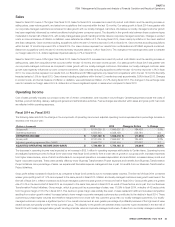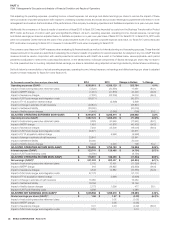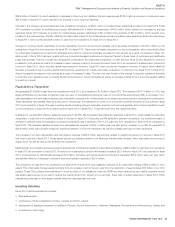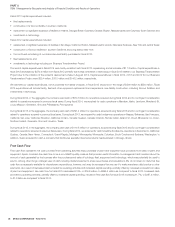Sysco 2014 Annual Report Download - page 38
Download and view the complete annual report
Please find page 38 of the 2014 Sysco annual report below. You can navigate through the pages in the report by either clicking on the pages listed below, or by using the keyword search tool below to find specific information within the annual report.SYSCO CORPORATION-Form10-K26
PARTII
ITEM7Management’s Discussion and Analysis ofFinancial Condition and Results of Operations
The decrease in operating income in scal 2013 as compared to scal 2012 was primarily driven by increased expenses, including charges related to our
Business Transformation Project and increased pay-related expenses. The decrease in adjusted operating income in scal 2013 as compared to scal
2012 was primarily driven by increased expenses, including increased pay-related expenses.
Gross pro t dollars increased in scal 2013 as compared to scal 2012 primarily due to increased sales. Gross margin was 18.01% in scal 2013, a decline
of 35 basis points from the gross margin of 18.36% in scal 2012. This decline in gross margin was partially the result of increased growth from corporate-
managed customers. Gross margin from these types of customers is generally lower than other types of customers. Increased competition resulting from
a slow-growth market also contributed to the decline in gross margins.
We estimate that Sysco’s product cost in ation was 2.2% during scal 2013. Based on our product sales mix for scal 2013, we were most impacted by
higher levels of in ation in the poultry and meat product categories.
Operating expenses for scal 2013 increased 7.6%, or $449.5 million, over scal 2012, primarily due to increased expenses from our Business Transformation
Project, pay-related expenses, charges related to multiemployer pension plan withdrawals, depreciation and amortization expense and fuel. Adjusted
operating expenses increased 4.5%, or $253.7 million, in scal 2013 over scal 2012. The increase in adjusted operating expenses was primarily due to
increased pay-related expenses, depreciation and amortization expense and fuel.
Operating Expenses Impacting Adjusted Operating Income
Pay-related expenses, excluding labor costs associated with our Business Transformation Project and retirement-related expenses, increased by $48.3million
in scal 2013 over scal 2012. The increase was primarily due to added costs from companies acquired in the last 12 months and increased delivery
and warehouse compensation. Delivery and warehouse compensation includes activity-based pay which increases when our case volumes increase.
Additionally, pay rates were higher particularly in geographies where oil and gas exploration occurs due to labor shortages. These increases were partially
offset by reduced sales and information technology pay-related expenses as a result of some of our Business Transformation Project initiatives. During scal
2013, we streamlined our sales management organization and modi ed marketing associate compensation plans. We also restructured our information
technology department during the mid-point of scal 2013, reducing headcount as a result.
Our retirement-related expenses consist primarily of costs from our Retirement Plan, SERP and our de ned contribution plan. The net impact in scal
2013 of our recurring retirement-related expenses, excluding charges noted below related to the executive retirement plans restructuring, was an increase
of $10.3 million as compared to scal 2012. This net increase consisted of $46.0 million increased recurring costs from the de ned contribution plan, a
$33.1 million decrease in our recurring net company-sponsored pension costs and a decrease of approximately $2.6 million for other costs. At the end
of scal 2012, Sysco decided to freeze future bene t accruals under the Retirement Plan as of December 31, 2012 for all U.S.-based salaried and non-
union hourly employees. Effective January 1, 2013, these employees were eligible for additional contributions under an enhanced, de ned contribution
plan. Absent the Retirement Plan freeze, net company-sponsored pension costs would have increased $106.9 million in scal 2013. During scal 2013,
we approved a plan to restructure our executive nonquali ed retirement program including the SERP and our executive deferred compensation plan. A
non-quali ed de ned contribution plan became effective on January 1, 2013 as a replacement plan and bene ts were frozen under the SERP at the end
of scal 2013. We believe this restructuring more closely aligned our executive plans with our non-executive plans. Additional non-recurring costs related
to the restructuring are discussed below under “Certain Items Within Operating Expenses.”
Depreciation and amortization expense, excluding the increase related to our Business Transformation Project described below, increased by $36.0 million
in scal 2013 over scal 2012. The increase was primarily related to assets that were not placed in service in scal 2012 that were in service in scal 2013,
primarily from new facilities, property from new acquisitions and expansions.
Fuel costs increased by $18.9 million in scal 2013 over scal 2012. The increase was primarily due to increased contracted diesel prices and increased
gallon usage. Our costs per gallon increased 2.8% in scal 2013 over scal 2012. Our activities to mitigate fuel costs include reducing miles driven by
our trucks through improved routing techniques, improving eet utilization by adjusting idling time and maximum speeds and using fuel surcharges. We
routinely enter into forward purchase commitments for a portion of our projected monthly diesel fuel requirements with a goal of mitigating a portion of
the volatility in fuel prices.
Our fuel commitments will result in either additional fuel costs or avoided fuel costs based on the comparison of the prices on the xed price
contracts and market prices for the respective periods. In scal 2013, the forward purchase commitments resulted in an estimated $17.8 million
of avoided fuel costs as the xed price contracts were generally lower than market prices for the contracted volumes. In scal 2012, the forward
purchase commitments resulted in an estimated $20.2 million of avoided fuel costs as the xed price contracts were generally lower than market
prices for the contracted volumes.
Our cost per case was an increase of $0.03 per case in scal 2013 as compared to scal 2012. Our adjusted cost per case calculated on a non-
GAAP basis decreased by $0.01 per case as compared to scal 2012 primarily from reduced pay-related expenses from our sales and information
technology areas, partially offset by increased costs from delivery and warehouse pay-related expenses, increased retirement-related expenses
and fuel increases.






